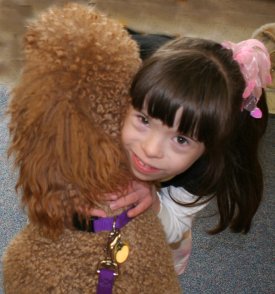Considering a Therapy or Service Assistance Dog for Your Special Needs Child? Pros and Cons
Insight into the benefits and practicalities of service assistance and therapy dogs for families with children who have physical disabilities. These dogs can be a joy and a wonderful asset for children with disabilities, but the reality may be more complicated than you expect.
By Deborah Hall
 Dogs
and children... if you are anything like me, you believe passionately
that this is a combination made in heaven. There is something about the
relationship that seems inherently designed for good things. For a child
with a disability and all the accompanying challenges most face, a dog
can be even more magical. And this is why the idea of acquiring an assistance
dog for a child makes a lot of sense and is, on paper at least, very appealing.
However, the actuality of such a step is far more complex and much harder
than it appears at first glance.
Dogs
and children... if you are anything like me, you believe passionately
that this is a combination made in heaven. There is something about the
relationship that seems inherently designed for good things. For a child
with a disability and all the accompanying challenges most face, a dog
can be even more magical. And this is why the idea of acquiring an assistance
dog for a child makes a lot of sense and is, on paper at least, very appealing.
However, the actuality of such a step is far more complex and much harder
than it appears at first glance.
Obviously each child presents a separate set of challenges, as does each family situation, dog, disability, etc. So anybody who is at all interested in looking into getting an assistance dog for a child with a disability (or even just a companion or therapy dog) should collect information on their own and not rely on generalities. But, in this brief article, I will address some of the more generic 'realities' about such an endeavor.
First of all, let's differentiate between 'assistance or service dog', 'companion dog' and 'therapy dog'. Terms are not always used consistently but, for our purposes here, these are the definitions:
Assistance or Service Dog
An Assistance or Service Dog is trained to perform specific physical tasks to assist a person with a disability, such as opening doors, turning on lights, retrieving dropped items, carrying things, and alerting to sounds. These dogs are normally trained and certified by assistance dog organizations and have full public access rights under the ADA law. (NOTE: there have been some cases where the public access rights of assistance dogs for children have been challenged. I am not an attorney or an expert on these matters so I cannot advise about them, but it is something I've encountered in my work in this field and feel it deserves mention here.).
Therapy Dog
A Therapy Dog is trained in basic obedience that provides companionship but does no specific tasking. These dogs are often graduates of assistance dog organizations and especially suited for this work because of temperament. They normally do not have public access rights and work mostly in the home. However, they are often invited to accompany the child into public places.
Companion Dog
A Companion Dog is a family pet with no specific training or certification. They do not have public access rights. If you are going to adopt a dog for this purpose, without going through a therapy/service dog organization, it recommended that you carefully select the dog breed or breeds in its mix. You consult with a vet or one of the therapy/service dog organizations to confirm that you are choosing a breed or assortment of breeds that offers the characteristics and traits that will best meet your child's needs.
 All
three of these kinds of dogs will, if partnered correctly with children,
provide the most important service of all: love, affection, acceptance,
and companionship to children too often disenfranchised and lonely. In
fact, in many cases, having a four-legged furry 'best pal' will act as
a social magnet, attracting other children, and therefore promoting positive
relationships that might otherwise be difficult to achieve. Children with
disabilities are 'different' and those 'differences' are sometimes seen
by peers as 'negatives'… something to be afraid of or uncertain about.
However, a child with a canine partner, while also seen as 'different'
is seen as 'different' in a good and appealing way. So not only does the
child have the comfort, security, and benefits of a loyal best friend
in their dog, but they often acquire more human friends because of the
dog.
All
three of these kinds of dogs will, if partnered correctly with children,
provide the most important service of all: love, affection, acceptance,
and companionship to children too often disenfranchised and lonely. In
fact, in many cases, having a four-legged furry 'best pal' will act as
a social magnet, attracting other children, and therefore promoting positive
relationships that might otherwise be difficult to achieve. Children with
disabilities are 'different' and those 'differences' are sometimes seen
by peers as 'negatives'… something to be afraid of or uncertain about.
However, a child with a canine partner, while also seen as 'different'
is seen as 'different' in a good and appealing way. So not only does the
child have the comfort, security, and benefits of a loyal best friend
in their dog, but they often acquire more human friends because of the
dog.
For children with specific physical disabilities, an assistance dog can provide specified help beyond the companionship. A child who must rely on others for everything (retrieval of a dropped toy, opening a door while negotiating a wheelchair or crutches) cannot develop independence in a natural progression. When this happens, self-esteem suffers and often there is an accompanying fear of being alone that inhibits natural curiosity and exploration. A child who is afraid of falling is less likely to feel comfortable alone in a room, out in the yard, or even going to the bathroom by themselves, but partnership with a dog tends to lessen fear. In addition, an assistance dog can 'alert' if there is a problem (barking for help or actually going to get a parent or other adult). In addition, these dogs are able to provide actual physical assistance to a fallen child (the dog stands close and braces while the child pulls him/herself up by grasping the dog).
Assistance dogs and therapy dogs can provide great help during various medical procedures as well, especially when physical or speech therapy is required. Imagine how much more motivated a child would be to walk across a room, in spite of pain, if their best friend is waiting with wagging tail and smiling face. Even in hospitals, assistance/service and therapy dogs can provide great comfort and distraction from unpleasant medical procedures, and are allowed into facilities in many instances. For speech therapy, reading to a dog has been proven over and over to provide great benefit. A child sitting next to a dog, petting the fur, while reading aloud literally lowers blood pressure and other stress factors. When this happens the reading experience is much more pleasant for the child, which means more time is spent practicing leading to improved performance.
 Okay.
Now you've read about some of the many benefits that result from such
a wonderful child/dog partnership. But unfortunately, there are some things
that won't be quite as positive… for the parents! It is very important
to understand that bringing another dependent living creature into a household
does not reduce the parents' workload and, in fact, increases it. A dog
is not a babysitter or a caregiver, and the working relationship between
dog and child must be constantly monitored as well as practiced. This
falls to the parents, obviously. Whenever there is an outing, both child
and dog must be 'handled' and monitored. When the child needs to go to
a public restroom, the parent must somehow manage him/herself, child,
and dog. Feeding a dog is not normally a difficult or time-consuming task,
but since the child is supposed to do as much as possible in terms of
dog care in order to maintain the all-important bond between dog and child,
the feeding process can take much, much longer, as can dog grooming and
bathrooming and cleanup. In other words, as stated, the parents' workload
grows exponentially! The easiest way to understand this is to consider
that the addition of a dog to a household is similar to adding another
child…a source of both great joy and work.
Okay.
Now you've read about some of the many benefits that result from such
a wonderful child/dog partnership. But unfortunately, there are some things
that won't be quite as positive… for the parents! It is very important
to understand that bringing another dependent living creature into a household
does not reduce the parents' workload and, in fact, increases it. A dog
is not a babysitter or a caregiver, and the working relationship between
dog and child must be constantly monitored as well as practiced. This
falls to the parents, obviously. Whenever there is an outing, both child
and dog must be 'handled' and monitored. When the child needs to go to
a public restroom, the parent must somehow manage him/herself, child,
and dog. Feeding a dog is not normally a difficult or time-consuming task,
but since the child is supposed to do as much as possible in terms of
dog care in order to maintain the all-important bond between dog and child,
the feeding process can take much, much longer, as can dog grooming and
bathrooming and cleanup. In other words, as stated, the parents' workload
grows exponentially! The easiest way to understand this is to consider
that the addition of a dog to a household is similar to adding another
child…a source of both great joy and work.
Sometimes parents think that a dog would be great for a child and forget to 'test' to see if the child even likes dogs, much less loves them! Without a pretty strong drive on the part of the child, this type of partnership will never work. There are many ways a parent can test their child's interest in dogs without actually getting one:
- visit an animal shelter,
- watch the reaction/interaction of the child with dogs of friends and family,
- find a service dog organization in the area and ask to visit (most such organizations welcome the addition of children and strangers as they train their dogs and it is a good environment in which to assure that the child is not in harm's way from unknown animals),
- rent a movie about dogs and see if the child is interested,
- read children's books about dogs,
- watch a lot of animal planet shows about dogs,
- and, of course, have conversations with the child (if possible) about how they feel about dogs.
This article is, as stated before, a very simplified overview and introduction to the complex and serious concept of a service/therapy dog for a child. Hopefully, it has at least triggered some important thinking, if not specific conclusions. Again, I strongly encourage anybody considering this as an option for his/her child to do a lot more research, including contacting me, if desired.
